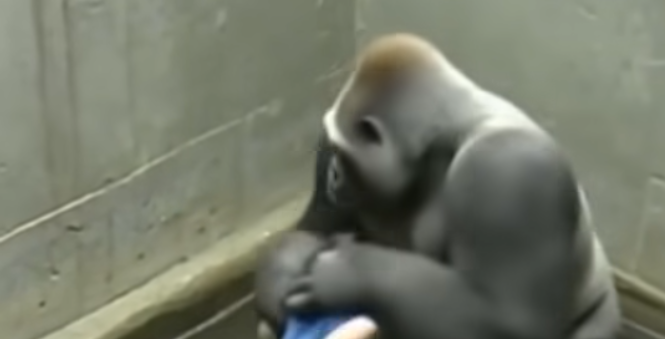Nearly a decade later, the name Harambe still provokes a visceral reaction — a mixture of sorrow, outrage, and unresolved debate. The 2016 shooting of the 17-year-old western lowland gorilla at the Cincinnati Zoo remains one of the most emotionally charged incidents in modern discussions of animal ethics and human responsibility.
For those who remember the footage, the scene is hard to forget: a small boy falls into the gorilla enclosure, chaos erupts among onlookers, and within moments, a 440-pound silverback is confronted with human panic on all sides. Then comes the gunshot — one that ended Harambe’s life but ignited a global conversation that refuses to fade.
At the heart of that conversation lies a question that has never been fully settled: Was Harambe a threat, or a misunderstood guardian?
The Incident That Shocked the World
On May 28, 2016, a three-year-old boy managed to climb into the gorilla enclosure at the Cincinnati Zoo. Witnesses later said they screamed as Harambe approached the child, lifting him up and, at times, dragging him through shallow water. Zoo staff made a split-second decision: shoot the gorilla to save the boy.
The boy survived with minor injuries. Harambe died instantly.
The footage, filmed by horrified onlookers, went viral within hours. The world watched, replayed, argued, and judged — not just the zoo, but humanity itself.
The Divided Interpretation
Experts still disagree on what Harambe’s behavior meant.
Some animal behaviorists insist his actions were protective, not predatory. They point to subtle cues — his body posture, how he positioned himself between the boy and the crowd, the lack of overt aggression. They argue Harambe might have been startled by the screaming humans, interpreting their panic as a threat to the child he was trying to shield.
Dr. Patricia Kane, a primate researcher who has studied gorilla social behavior for 30 years, explained in a 2022 retrospective, “Harambe showed signs of stress but also signs of curiosity. In several frames, you can see him touch the boy gently, the way silverbacks often check on younger members of their troop.”
Others disagree sharply.
“Harambe’s strength alone made the situation unmanageable,” countered zoo safety consultant David Rankin. “Even if his intentions were neutral, the child was in immediate danger. Gorillas can crush bones with a single motion — you can’t risk ‘interpreting’ in that moment.”
This clash of interpretations defined the debate: Was Harambe a victim of human fear and institutional liability, or a necessary casualty of human safety protocols?
The Broader Reckoning
Harambe’s death became more than an isolated tragedy — it became a mirror.
In the weeks that followed, conversations about zoos exploded across social media, classrooms, and living rooms. Memes were made, protests staged, think pieces written. The event forced millions to confront uncomfortable truths about captivity, conservation, and our moral relationship with intelligent non-human life.
For some, Harambe’s death symbolized humanity’s arrogance — the belief that we can contain and control wild animals for our own purposes. For others, it underscored the impossible position zoos face: balancing education and safety against the natural instincts of the creatures they exhibit.
As author and animal ethicist Dr. Michael Sandor put it, “The Harambe case exposed a paradox: Zoos exist to protect endangered species, yet their very existence depends on keeping those species confined. The boy’s fall wasn’t just an accident — it was a metaphor for our collective failure to understand the consequences of that confinement.”
Zoos Under the Microscope
In the years following the incident, zoos worldwide launched sweeping safety reviews. New regulations were introduced to strengthen barriers, redesign enclosures, and retrain staff for emergency responses. Some institutions even implemented “psychological safety audits,” studying not just physical security but how enclosure design impacts animal behavior under stress.
The Association of Zoos and Aquariums (AZA) mandated new standards for visitor barriers and emergency procedures. “Harambe’s death was a wake-up call,” said AZA spokesperson Elaine Cooper in 2019. “We learned the hard way that even one unpredictable event can redefine public trust.”
Many zoos also began reevaluating how they present animals to the public. Interactive enclosures and behind-glass exhibits became more common, reducing the illusion of intimacy that once blurred the line between human spectator and animal inhabitant.
The Human Element
Beyond the ethics and policy debates, there were the human stories — messy, emotional, often contradictory.
The child’s family faced intense scrutiny, even death threats. The zoo’s director, Thane Maynard, endured global criticism and still defends the decision. “It was a heartbreaking call,” he told reporters. “But we made it to save a child’s life. No one wins in a situation like that.”
Meanwhile, zookeepers who had cared for Harambe mourned not only a beloved animal but a friend. They described him as intelligent, playful, and deeply social — a creature who recognized faces, remembered routines, and showed emotions most people never believed gorillas could have.
One keeper, speaking anonymously, recalled: “He wasn’t just an exhibit. He had moods, humor, frustration. Losing him was like losing a colleague.”
A Symbol That Endures
Nearly ten years on, Harambe’s legacy is complex. He became both a symbol of tragedy and a strange pop-culture phenomenon — immortalized in memes, protest slogans, and internet folklore. The irony of that transformation is not lost on scholars: the same society that condemned his death also commodified his image, turning grief into viral entertainment.
Yet beneath the noise, something deeper endures. His story continues to challenge how we define our moral duty to other sentient beings.
Was Harambe an animal acting on instinct or a thinking, feeling creature reacting to chaos? Should human safety always come first, even when the risk is uncertain? And most of all — is it right to keep intelligent animals in captivity, no matter how “humane” the conditions appear?
The Uncomfortable Truth
There are no easy answers. Harambe’s death exists in a gray space where ethics, fear, and empathy collide. It forced society to admit that our relationship with nature is still fundamentally broken — defined by control rather than understanding.
For some, Harambe remains a cautionary tale about the dangers of captivity. For others, a tragic reminder that even our best intentions can lead to unbearable consequences.
But for many, his story has become something else entirely — a moral checkpoint. A moment when the world was forced to pause and ask: What are we really protecting — the animals, or our illusion of control over them?
Nearly a decade later, the question still hangs unanswered.
And maybe that’s Harambe’s true legacy — not a resolution, but a haunting reminder that compassion without comprehension can be just as dangerous as indifference.
In that sense, Harambe never really left us. He lives on in every ethical debate about captivity, every safety reform, every whispered argument about the price of progress. His final moments continue to echo, not just through the concrete walls of a zoo in Cincinnati, but in the uneasy conscience of everyone who watched — and still wonders what might have been if we had understood him better.



